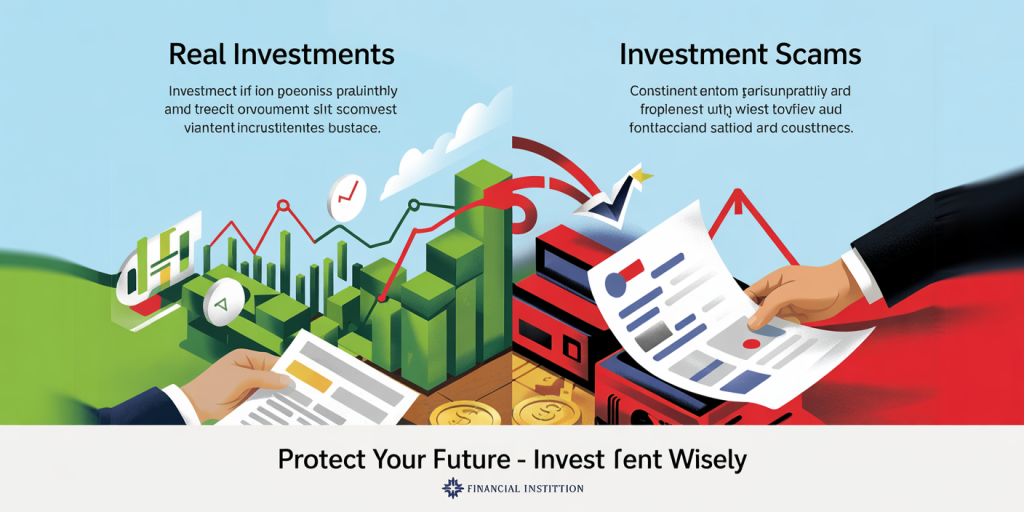How to Identify and Avoid Common Investment Scams
Anúncios
Investment scams continue to pose significant risks to individuals seeking to grow their wealth. According to the U.S. Federal Trade Commission (FTC), Americans lost more than $1 billion to investment scams in 2022 alone, highlighting the critical need for investor vigilance. These scams often promise unrealistic returns with little or no risk, preying on people’s desire for financial security. Developing an understanding of how to identify and avoid these schemes is essential for anyone looking to safeguard their assets and make informed investment decisions.
This article provides a comprehensive guide to recognizing common investment frauds, complete with real-life examples, practical tips, and comparative insights. By understanding the typical characteristics and warning signs of scams, investors can better protect themselves from financial loss.

Recognizing Common Types of Investment Scams
Anúncios
Investment scams come in various forms, tailored to exploit different investor profiles. Understanding the most prevalent types is the first line of defense against potential fraud.
Ponzi Schemes and Pyramid Frauds
Anúncios
Ponzi schemes offer high returns by using the capital from new investors to pay earlier investors, rather than from profit earned by the operation. Bernie Madoff’s infamous Ponzi scheme, which defrauded investors of an estimated $65 billion, is a prime example. Madoff promised consistent, above-market returns, attracting thousands of victims worldwide until the fraud unraveled in 2008.
Pyramid schemes, closely related, require participants to recruit others to join, with returns based on recruitment rather than genuine investment. The initial promoters gain large profits, but the model collapses when there are not enough new recruits. Both Ponzi and pyramid scams typically emphasize quick returns with minimal risk, a red flag for potential investors.
Advance Fee and Boiler Room Scams
Advance fee scams request upfront payment for services that are never delivered, often disguised as investment opportunities. Victims may be convinced to pay fees for tax avoidance services or “exclusive” investment deals but never receive promised benefits.
Boiler room scams operate by using high-pressure sales tactics over the phone to convince investors to buy worthless or overvalued shares. These operations typically promote penny stocks or fake companies, generating quick commissions for the fraudsters but losses for investors.
Common Warning Signs and Red Flags
Recognizing the subtle and overt warning signs of a scam can save investors from significant loss. Understanding these indicators often helps differentiate legitimate offers from fraudulent ones.
Unrealistic Promises and Pressure Tactics
One of the most common red flags is the promise of extraordinarily high or guaranteed returns. No investment is risk-free, and returns that sound too good to be true usually are. For example, a typical legitimate stock market investment averages about a 7-10% annual return, yet many fraudsters promise returns of 20%, 50%, or even higher, with “no risk.”
Pressure or urgency is another indicator. Scammers often rush investors to act immediately, portraying the opportunity as “exclusive” or “limited time only.” This tactic is designed to circumvent due diligence and rational decision-making.
Lack of Transparency and Documentation
Legitimate investments provide clear, verifiable information including prospectuses, audited financial statements, and registrations with regulatory bodies such as the Securities and Exchange Commission (SEC) or the Financial Industry Regulatory Authority (FINRA). When sellers avoid providing proper documentation or tell investors to trust verbal assurances, it should raise concerns.

For instance, in the case of the 2020 OneCoin cryptocurrency scam, the operators avoided disclosing vital information and promised investors sky-high returns, which led to a global fraud netting $4 billion.
Effective Strategies to Avoid Investment Scams
Being proactive and educated is key to steering clear of investment fraud. Investors should adopt a multi-step approach to mitigate risks.
Conduct Thorough Due Diligence
Before committing funds, verify the legitimacy of the investment and the credentials of those offering it. Use resources like the SEC’s EDGAR database to check company filings and BrokerCheck by FINRA to assess the background of brokers and investment advisers.
Additionally, check for any history of regulatory violations, complaints, or criminal charges. A quick internet search can reveal red flags or past reports by other investors. Employing the expertise of a certified financial adviser can provide an objective assessment, especially for complex opportunities.
Diversify Investments and Avoid “All-In” Approaches
Diversification reduces the risk of total loss caused by a scam. Instead of putting all funds into one opportunity, spread investments across multiple asset classes and companies with transparent track records.
Investors should be cautious of “all-in” pitches, especially those urging the transfer of money or assets quickly. Taking the time to consult trusted financial institutions and advisors can help avoid impulsive decisions driven by fraudsters’ manipulations.
Comparison of Legitimate Investments vs. Scams: Key Characteristics
| Aspect | Legitimate Investments | Investment Scams |
|---|---|---|
| Return Claims | Moderate, market-based, no guaranteed returns | Exaggerated, guaranteed, and unrealistic |
| Documentation Provided | Detailed prospectus, audited reports, SEC filings | Vague, nonexistent, or unverifiable documents |
| Regulatory Registration | Registered with SEC, FINRA, or equivalent | Unregistered or falsely claiming registration |
| Pressure to Invest Quickly | No urgency, time to assess | High-pressure sales tactics, urgency claims |
| Transparency of Operations | Clear business model and financials | Secretive, complex, or confusing structures |
| Communication Style | Professional, clear, explain risks thoroughly | Overly friendly, overly aggressive, evasive |

Practical Examples Illustrating Scam Mechanisms
The Wirecard Scandal: Corporate Fraud
Wirecard, a German payment processor, was once hailed as a fintech success story before it collapsed in 2020 following revelations it had falsified €1.9 billion in cash balances. Investors were misled by fabricated financial data that masked the company’s weaknesses. Wirecard’s case highlights the importance of scrutinizing financial statements independently and not relying solely on company-provided information.
Cryptocurrency Investment Frauds
The rapid growth of cryptocurrencies has attracted scammers. According to Chainalysis, cryptocurrency-related scams reached nearly $1.9 billion globally in 2023. Fraudsters often market fake ICOs (Initial Coin Offerings) or promise “mining” returns. One well-known case is BitConnect, which operated as a Ponzi scheme and collapsed in 2018, causing investors to lose over $2.6 billion.
Leveraging Technology and Regulation to Stay Ahead
Regulatory agencies globally have ramped up efforts to curb investment fraud via better legislation and enforcement. For example, the SEC passed the Regulation Best Interest rule designed to enhance broker responsibilities in ensuring investor protection.
Technology also plays a critical role. Artificial intelligence-powered platforms now track suspicious investment offers on social media or unreliable websites, flagging scams quickly. Many investors utilize online tools and apps to verify seller credentials and cross-check information in real-time.
Additionally, increased investor education campaigns by governments and financial institutions have helped raise awareness. The FTC’s initiative urging investors to “Do Your Homework” before any investment is a reminder that skepticism and research are powerful defenses.
Future Perspectives on Investment Scam Prevention
As investment products and platforms evolve, so do the tactics used by fraudsters. The growth of decentralized finance (DeFi), cryptocurrencies, and complex financial derivatives may present new opportunities for scams but also new detection tools. Regulatory authorities are continuously adapting by increasing cross-border cooperation and utilizing machine learning to monitor market activities more effectively.
Artificial intelligence combined with blockchain analytics holds promise for preventing fraud, by enabling real-time flagging of suspicious transaction patterns and ensuring transparency. Investors will increasingly benefit from these advancements, but the onus remains on each individual to maintain vigilance.
Furthermore, education remains crucial. Continued efforts to improve financial literacy at all levels will empower more people to recognize fraud risks before committing funds. Consumer protection laws are expected to strengthen, closing loopholes exploited by scammers.
Investors who educate themselves on common scam tactics, perform rigorous due diligence, and leverage modern technology stand a much better chance of safeguarding their capital. With ongoing advancements in regulatory frameworks and analytic capabilities, the future promises a safer investment landscape—provided individuals remain cautious and informed. Staying engaged, skeptical, and methodical when making investment decisions is the best strategy to avoid falling victim to fraudulent schemes.



Post Comment